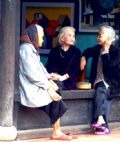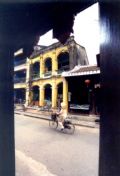|
|

Hoi An in night.

Ancient roof of Phuc Kien
Pagoda.

Lifestyle of
Hoi An
locals has
been preserved.nbsp;

The
pagoda-bridge
with typical architecture of Hoi An.

A charming feature
of Hoi
An.

Foreign tourists like to
buy fruits sold on mobile
vendors. This is one of the local
long-standing practices.nbsp;

Chinese-style
architecture
remains at Tan Ky house, which is more than 200 years
old.
|
Do people call it
physical and non-physical culture? Whether they think of it this way or
dream of it another way, they have to recognize it when staying
in the heart of the ancient town of Hoi An, day and
night.
In the late
afternoon, Hoi An brightens with a golden sunshine. As an old seaport,
just like so many other harbours in the world, Hoi An always becomes
animated in the afternoon, which is the transition from day to night, and
the harmony between the mainland and the sea, between reality and
imagination.
Quite a few people like to take a stroll on
the old streets about this time. They are charmed by the Pagoda-Bridge,
built by the Japanese merchants in the late 16th and early 17th
centuries, that crosses the stream flowing into the Hoai River. The
12m-long pagoda was erected in a very particular style with its roof
covered with yin-yang tiles.nbsp; Both the pagoda and the bridge are made
of wood, delicately carved and engraved, with the façade looking over the
riverbank. The two ends are adorned with wooden animal-figures, two dogs
at one end and two monkeys at the other. As the legend goes, they have
long been the Japanese people’s cult animals. The centre is dedicated to
the Northern Genie Tran Vo, the Protector, who is believed to grant joy
and happiness to all.
Most of the streets in town are as they were
centuries ago, with tube-houses running through two ends at two different
streets, from one to the other. One of the streets stands next to the
river bank with longer tube-houses with an open space in the middle,
covered with mossy yin-yang tiles showing the wear and tear of time. One
may feel some nostalgia of a period when the storefronts looked to the
street, their backs to the sea, and their open spaces filled with products
from China and Japan, Portugal and Italy …nbsp; a few centuries ago. In
general, the houses are all built of rare wood, decorated with horizontal
lacquered boards, columns and vertical parallels engraved with very
intricate decorative designs.
Hoi An even nurtures spots of native
culture: Kim Bong carpentry village, Tra Que market-gardening village, Cua
Dai Beach, Cham Islets, Thuan Tinh eco-region, Thanh Ha pottery village…
At Thanh Ha pottery village, you may easily recognize one of its features:
the potter’s wheel. The piece includes only a small wooden plank called “
sò ” to form the shape of the product and a wetted rag to achieve
its glaze. That’s all. It seems that over the past 600 years, so many
scientific-technological achievements have gone unheeded in this
handicraft village. The artisans work without machinery, moulds or any
other modern pieces of equipment. Regularly, a piece of clay comes out
every 5 minutes, a product turns out every 10 minutes… The potter’s foot
works regularly and rhythmically, spinning the potter’s wheel to churn out
his products. History tell us that Thanh Ha used to produce bricks and
tiles for the construction of the ancient town of Hoi An.
In the late afternoon and then in the
fall of the evening, the light from the lanterns brings you back to the
environment of the thousand and one nights, or the atmosphere of the Red
Chamber Dream in ancient China. All is real, yet seemingly so imaginary.
Through the open little window-frames, you may notice people playing chess
or cards, stitching… There you may realize something seemingly unchanged
in the changeable society, which has become a value - i.e. a cultural
style that defies all newfangled alien influences.
A foreign visitor was once asked: How do you
find Hoi An? He did not hesitate to answer: “Hoi An always remains Hoi
An.” This seemingly simple statement implies man’s very great values.
People have preserved Hoi An with its eternal
values.nbsp;
nbsp;
nbsp;
nbsp;
nbsp;
nbsp;
|

nbsp; |
* Ancient
Town of Hoi An, formerly known as Dai Chiem Port, represents
one of the most ancient cities of Southeast Asia that has been
kept virtually intact. In the past it used to be called
Faifoo, popularly known among the merchants from Japan, China,
Portugal, Italy … as early as the 16th-17th
centuries. Then the sea port of Hoi An was very prosperous as
a huge trading centre of Southeast Asia, one of the main
stop-over ports of the Far East.
*nbsp;Hoi An is located in Quang Nam Province in
Central Vietnam, bordering on Thua Thien-Hue Province and Da
Nang City in the North, on Laos in the West, on Quang Ngai
Province in the South and on the East Sea in the East, with
Cham Islet nbsp;as its immense fishing grounds.
|
|
nbsp; | |
nbsp;
nbsp;
nbsp;
nbsp;
nbsp;
nbsp;
nbsp;
Story: Nguyen
Van |